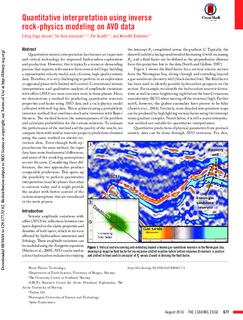| dc.contributor.author | Jensen, Erling Hugo | |
| dc.contributor.author | Johansen, Tor Arne | |
| dc.contributor.author | Avseth, Per Åge | |
| dc.contributor.author | Bredesen, Kenneth | |
| dc.date.accessioned | 2017-12-11T13:12:04Z | |
| dc.date.available | 2017-12-11T13:12:04Z | |
| dc.date.created | 2016-09-28T10:55:51Z | |
| dc.date.issued | 2016 | |
| dc.identifier.citation | The Leading Edge. 2016, 35 (8), 677-683. | nb_NO |
| dc.identifier.issn | 1070-485X | |
| dc.identifier.uri | http://hdl.handle.net/11250/2470343 | |
| dc.description.abstract | Quantitative seismic interpretation has become an important and critical technology for improved hydrocarbon exploration and production. However, this is typically a resource-demanding process that requires information from several well logs, building a representative velocity model, and, of course, high-quality seismic data. Therefore, it is very challenging to perform in an exploration or appraisal phase with limited well control. Conventional seismic interpretation and qualitative analysis of amplitude variations with offset (AVO) are more common tools in these phases. Here, we demonstrate a method for predicting quantitative reservoir properties and facies using AVO data and a rock-physics model calibrated with well-log data. This is achieved using a probabilistic inversion method that combines stochastic inversion with Bayes’ theorem. The method honors the nonuniqueness of the problem and calculates probabilities for the various solutions. To evaluate the performance of the method and the quality of the results, we compare them with similar reservoir property predictions obtained using the same method on seismic-inversion data. Even though both approaches use the same method, the input data have some fundamental differences, and some of the modeling assumptions are not the same. Considering these differences, the two approaches produce comparable predictions. This opens up the possibility to perform quantitative interpretation in earlier phases than what is common today, and it might provide the analyst with better control of the various assumptions that are introduced in the work process. | nb_NO |
| dc.language.iso | eng | nb_NO |
| dc.publisher | Society of Exploration Geophysicists | nb_NO |
| dc.title | Quantitative interpretation using inverse rock-physics modeling on AVO data | nb_NO |
| dc.type | Journal article | nb_NO |
| dc.type | Peer reviewed | nb_NO |
| dc.description.version | publishedVersion | nb_NO |
| dc.source.pagenumber | 677-683 | nb_NO |
| dc.source.volume | 35 | nb_NO |
| dc.source.journal | The Leading Edge | nb_NO |
| dc.source.issue | 8 | nb_NO |
| dc.identifier.doi | 10.1190/tle35080677.1 | |
| dc.identifier.cristin | 1386772 | |
| dc.relation.project | Norges forskningsråd: 228107 | nb_NO |
| dc.description.localcode | © 2016 Society of Exploration Geophysicists. Use is subject to SEG terms of use and conditions. | nb_NO |
| cristin.unitcode | 194,64,90,0 | |
| cristin.unitname | Institutt for geovitenskap og petroleum | |
| cristin.ispublished | true | |
| cristin.fulltext | original | |
| cristin.qualitycode | 1 | |
